 |
|
|
|
|
Preparing
for firing : Extracted from the book : Leopold by Jan Coen WIjnstok / ISBN-83-920254-5-8) In transport, K5 and the Vögele Brehscheibe (Turntable) were concealed under tarpaulins over a framework, to make them look like normal box cars. On arrival, the tarpaulins and frames would be taken off first and laid to the side. 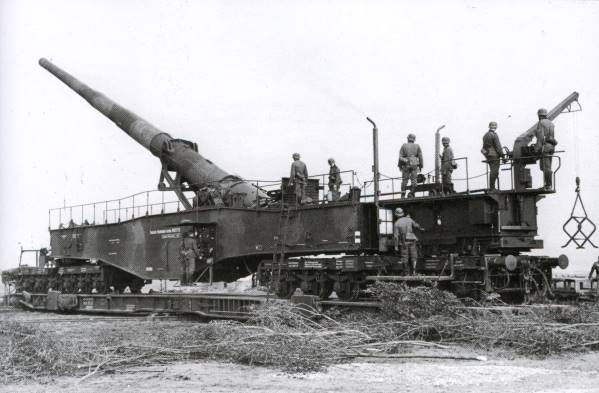 The handbrake of the front
railway truck was applied. The chain connecting the rear railway
truck and the gondola of the gun was unhooked and hung on the
gondola. A three way valve next to the aiming stand regulated the
compressed air system. It was moved from 'transpot mode' to
'closed', and then the pressure hose was closed, and uncoupled from
an angle cock beneath the aiming stand. The front locking system of
the gondola was unlocked, and it was raised slightly by hydraulics
to make moving it easier. From the transport position, the rear
railway truck was moved backwards 1.9 m to its firing position and
locked in place with the rear locking mechanism.
The rear railway truck could be moved either by locomotive or by
hand. The pressure hose was then reconnected to a valve further back
on the gondola. The three way valve was set to 'firing mode'. Firing
mode didn't make the gun immobile. The
extra length would make it harder to operate on the railway for long
distance transport. The generator had to be moved from its transport
position on the ammunition supply car to the rear railway truck.
Rails were fixed between them. The generator was jacked up and put
on rollers, one side at a time. It was then pulled onto the rear
railway truck by means of pulleys attached to eyes on the back of
the gondola. The rollers were removed and the generator secured to
the rear railway truck. The electrical connections were then made.
Meanwhile, the railings would have been erected., ladders extended
or attached, the barrel clamp released, the cover removed from the
barrel, the aiming stand put into operation and all equipment needed
to operate the gun put in place The handbrake of the front
railway truck was applied. The chain connecting the rear railway
truck and the gondola of the gun was unhooked and hung on the
gondola. A three way valve next to the aiming stand regulated the
compressed air system. It was moved from 'transpot mode' to
'closed', and then the pressure hose was closed, and uncoupled from
an angle cock beneath the aiming stand. The front locking system of
the gondola was unlocked, and it was raised slightly by hydraulics
to make moving it easier. From the transport position, the rear
railway truck was moved backwards 1.9 m to its firing position and
locked in place with the rear locking mechanism.
The rear railway truck could be moved either by locomotive or by
hand. The pressure hose was then reconnected to a valve further back
on the gondola. The three way valve was set to 'firing mode'. Firing
mode didn't make the gun immobile. The
extra length would make it harder to operate on the railway for long
distance transport. The generator had to be moved from its transport
position on the ammunition supply car to the rear railway truck.
Rails were fixed between them. The generator was jacked up and put
on rollers, one side at a time. It was then pulled onto the rear
railway truck by means of pulleys attached to eyes on the back of
the gondola. The rollers were removed and the generator secured to
the rear railway truck. The electrical connections were then made.
Meanwhile, the railings would have been erected., ladders extended
or attached, the barrel clamp released, the cover removed from the
barrel, the aiming stand put into operation and all equipment needed
to operate the gun put in place |
|
K5
could either been fired from a curved length of railway (Schiesscurve) or
from the Vögele Drehscheibe. In the first case, the gun would be aimed
roughly by shunting forward or backward. Handbrakes were applied and a
ruler was attached to the track forward of the aiming stand to measure
backslide caused by recoiled. The gun could then be accurately
repositioned after firing.
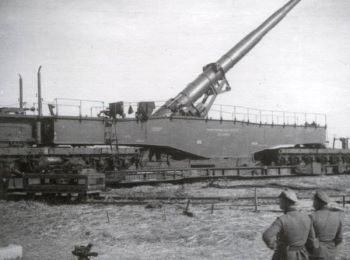 Ammunition cars would be placed away from the gun, fuses were set here and
charges prepared. Projectiles and charges were stowed in sperate cars.
They were loaded onto ammunition trolleys, with the projectile in the
middle and the charges stowed to the sides. Rails ran along the length of
the ammunition cars and between them, the latter movable, to allow the
trolley to move through them. The ammunition supply car was used to bring
the trolleys to the gun. It
operated under its own power. The Vögele COmpany produced turntables for
conventional railway purposes; these were used, for instance, to turn
locomotives around in railway yards.
Ammunition cars would be placed away from the gun, fuses were set here and
charges prepared. Projectiles and charges were stowed in sperate cars.
They were loaded onto ammunition trolleys, with the projectile in the
middle and the charges stowed to the sides. Rails ran along the length of
the ammunition cars and between them, the latter movable, to allow the
trolley to move through them. The ammunition supply car was used to bring
the trolleys to the gun. It
operated under its own power. The Vögele COmpany produced turntables for
conventional railway purposes; these were used, for instance, to turn
locomotives around in railway yards.
The Vögele Drehscheibe was conceived between the two World Wars, during
the same studies that produced the theoretical basis for the development
of K5. It consists of a circular rail and a firing bec, to give a 360
degree arc of firing, it was used with other railway guns as well. The
firing bed rotated on a pivot attached to the railway and the circular
rail. A complete K5 was moved onto the firing bed and secured to recoil
and recuperator cylinders on the front of the firing bed. The large
coupling is used for this. The gun's generator also powered the firing
bed.
When using the turntable, ammunition trolleys were transferred from the
ammunition supply car to a special car running on the rail of the
turntable to get them to the gun. The trolley was hoisted to the loading
platform and rolled to the breech. The granate was loaded using a rammer.
The charge consisted of several bags of propellant, the main one in a
metal cartridge. The bags and the cartridge were put in the chamber with
another rammer. Both rammers were stored on the loading platform. The
breech could now be closed. The loading flap was raised and the gun was
aimed from the aiming stand and fired by means of a lanyard.
Officially all personnel had to be off the gun when firing. After firing
the cartridge was caught on the cartridge catcher that swiveled to the
side in order to reload the gun. The gun was reloaded and the empty
cartridge was put on the empty trolley and hoisted to the ground.
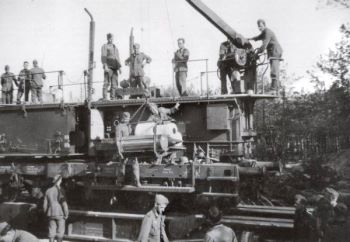 This
is a very good view of the generator and crane in action. The railings on
the generator unit are small; the large gap was necessary to accommodate
the ammunition trolley. Note that it can be closed with chains. The
instrument panel of the generator can be seen clearly. The inside of
the door is padded and probably white or off-white. The carriage number on
the generator is 919201. The wheels of the ammunition trolley have round
holes.
(Marcel Verhaaf Collection)
This
is a very good view of the generator and crane in action. The railings on
the generator unit are small; the large gap was necessary to accommodate
the ammunition trolley. Note that it can be closed with chains. The
instrument panel of the generator can be seen clearly. The inside of
the door is padded and probably white or off-white. The carriage number on
the generator is 919201. The wheels of the ammunition trolley have round
holes.
(Marcel Verhaaf Collection)
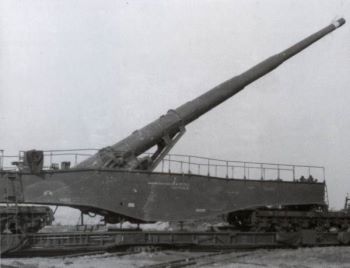
This is the
carriage number 919214 seen from the other side. The layout of the aiming
stand's instrument panel can be seen quite well. The
soldier on the right is setting the sight. Beneath it is the hand wheel
that controls the speed of traverse and elevation. To
the right of the instrument panel is the three way valve for the pressure
system. The platform is
detachable and hangs from pegs on the gondola; note the folding step.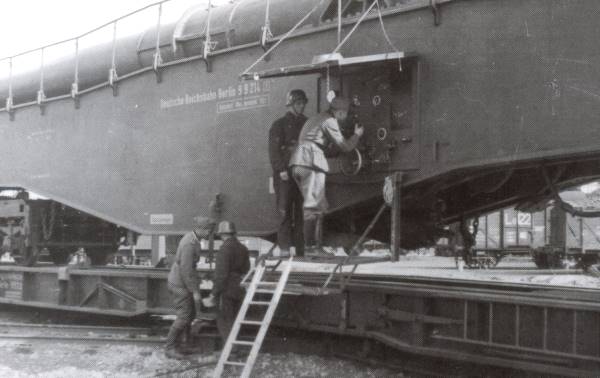 The two men on the left have folded down the indicator for recoil slide.
There is a white strip on the firing bed that could be the ruler. The
pressure hose attached to the rearmost cock is in the far right of the
photograph. Details of the firing bed can be seen very well.
The two men on the left have folded down the indicator for recoil slide.
There is a white strip on the firing bed that could be the ruler. The
pressure hose attached to the rearmost cock is in the far right of the
photograph. Details of the firing bed can be seen very well.
(Marcel Verhaaf Collection)
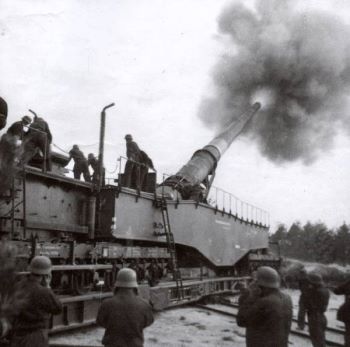
K5 Firing a round, the men on the
gun are bracing themselves for the recoil. All personnel seem to be
wearing overalls.
The pivot of the firing bed can be seen resting on the existing rail
across which the turntable is built.
No carriage number can be read (Marcel Verhaaf Collection)
Beginning of
the Atlantic Wall : (page 190)
Extracted from the book
: Fortress Third Reich by J.E.Kaufmann & H.K.Kaufmann - ISBN
0-306-81239-8
The K-type 280mm railway guns could move on their railroad carriage
into these dome bunkers, sometimes called cathedral bunkers. Once
inside the armored doors, the concrete shelter provided all the protection
needed as long as the guns were not in the firing position. These bunkers
were large enough to house the two 280mm guns and the locomotive of one
battery. One of these dome bunkers was situated on the northwest side of
Calais, about one kilometer from the coast. Another one was at Vallée
Heureuse, about four kilometers east of Marquise, almost half
way between Calais and Boulogne, about six kilometers from the
coast. A third one was at about one kilometer north of Wimereux,
five kilometers north of Boulogne, near the coast. A fourth even
larger bunker for a railroad gun battery was built later, not far from the
first dome bunker near Calais.
Since the big K-type rail guns were too large for their own carriage to
mount a turntable, curved sections of track were used for aiming. After
1936 the Vögele turntable was adopted. It consisted of a platform
on which the gun car was mounted and which revolved around a circular
track for aiming the gun. This made it possible for the gun to cover a
full 360 degrees. The Vögele turntable was transported with each
gun and assembled at the firing site. Nine railway artillery regiments
totaling sixteen batteries were available in the summer of 1940. Some of
them were stationed on the Channel coast during the autumn of 1940. The
navy also had one of the two 150mm rail-gun batteries known as Batterie
Gneisenau. ...
|
|
||||||
|
©
one35th - Last updated on :
Sunday, April 27, 2008 |
|||||